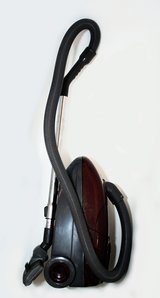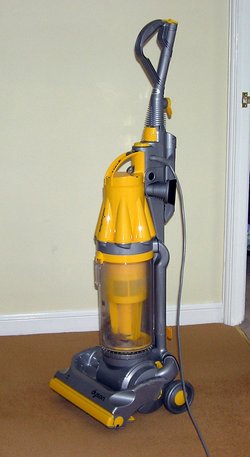Vacuum cleaner

A vacuum cleaner is a device that uses an air pump to create a partial vacuum to suck up dust and dirt, usually from carpeted floors. Most homes with carpeted floors possess a domestic model for cleaning. The dirt is collected by a filtering system or a cyclone for later disposal.
Configurations
Several general configurations for vacuum cleaners have emerged:
- Upright vacuum cleaners have the pump mounted directly above the suction outlet, with the bag mounted on the handle which rises to approximately waist height. Upright designs usually employ mechanical beaters to help disturb dust to be vacuumed up; these beaters are usually driven via a belt from the vacuum motor.
- Canister (or cylinder) designs have the motor and bag in a separate canister unit (usually mounted on wheels) connected to the vacuum head by a flexible hose. Upright units, mainly due to the effects of the beaters, have been shown in tests to be more effective, but the lighter, more manoeuverable heads of canister models are popular. Some upmarket canister models have "power heads" which contain the same sort of mechanical beaters as in uprght units (but driven by a separate electric motor).
- Back-pack vacs are commonly used for commercial cleaning as they allow the user to rapidly move about a large area. They are just like canister vacuum cleaners except that the canister unit is carried by straps on the user's back.
- Built-in or central vacuum cleaners move the suction motor and bag to a central location in the building and provide vacuum inlets at strategic places throughout the building; only the hose and pickup head need be carried from room to room and the hose is commonly 8 m (25 feet) long allowing a large range of movement without changing vacuum inlets. Plastic piping then connects these vacuum outlets to the central unit. The vacuum head may be unpowered or may have beaters operated by either an electric motor or an air-driven motor. The dirt bag in a central vacuum system is usually uncommenly large and may only require changing once per year.
- Robotic vacuum cleaners that drive around autonomously, usually in a mostly chaotic pattern ('random bounce'). Some come back to a docking station to charge their batteries and a few are able to empty their dust containers into the dock as well.
- Small hand-held vacuum cleaners, either battery-operated or electric, are also popular for cleaning up spills.
Most vacuum cleaners are supplied with attachments that allow them to reach otherwise inaccessible places or for cleaning curtains and furnishings.
History
The first hand-powered cleaner using vacuum principles may have been the "Whirlwind", invented in Chicago in 1865.
The first powered cleaner employing a vacuum was patented by H. Cecil Booth, a British engineer in 1901. He noticed a device used in trains that blew dust off the chairs, and thought it would be much more useful to have one that sucked dust. He tested the idea by laying a handkerchief on the seat of a dinner chair, putting his mouth to it and sucking hard. He nearly choked, but upon seeing the dust and dirt collected on the underside of the handkerchief he realised the idea could work. He patented it in Britain, creating a large petrol-powered horse-drawn vacuum cleaner known as the Puffing Billy that would park outside a building to clean it, although Booth never had great success with it.

In 1905 'Griffith's Improved Vacuum Apparatus for Removing Dust from Carpets' was another manually operated cleaner, patented by Walter Griffiths Manufacturer, Birmingham, England. It was a portable and easy to store vacuum device which was powered by "any one person (such as the ordinary domestic servant)" who would have the task of compressing a bellow type contraption to suck up dust via a removable, flexible pipe to which a variety of shaped nozzles could be attached. This was arguably the first domestic vacuum cleaning device to resemble the modern day vacuum cleaner.
Another inventor, in the United States, had much better luck with an electric vacuum cleaner. In 1906 James Murray Spangler, a janitor in Canton, Ohio, rigged a vacuum cleaner out of a fan, a box, and a pillowcase. In addition to suction, Spangler's design incorporated a rotating brush to loosen debris. He patented it in 1908 and eventually sold the idea to his cousin's "Hoover Harness and Leather Goods Factory." In the USA, Hoover remains one of the leading manufacturers of household goods including cleaners, and Hoover became very wealthy from the invention.
In Britain, Hoover has become so associated with the manufacture of vacuum cleaners that in English, "Hoover" is virtually a synonym of vacuum cleaner, indeed many people will often refer to their "hoover" and "doing the hoovering" even if the machine has been made by another manufacturer.
For many years after their introduction, they remained a luxury item, but after World War II, vacuum cleaners became ubiquitous amongst the rising middle classes. They tend to be more common in Western countries because, in some parts of the world, wall-to-wall carpeting is uncommon and homes have tile or hardwood floors.
Recent developments
Vacuum cleaners working on the cyclone principle became popular in the 1990s. These were adapted from industrial cyclonic seperators by James Dyson in 1985. He launched his cyclone cleaner first in Japan in the 1980s at a cost of approx $1,800 and later the Dyson DC01 upright in the UK in 1995 for £200. It was expected that people would not buy a vacuum cleaner at twice the price of a normal cleaner, but it later became the most popular cleaner in the UK. Air is forced around at high speed in a tighter and tighter circle inside a collection vessel. The dust particles move to the outside of the vessel by centrifugal force, and clean air from the center of the vortex is expelled from the machine. Since Dyson, several companies have adopted cyclone models, including Hoover.
In early 2000 several companies developed robotic vacuum cleaners. Some examples are Roomba, Robomaxx, Trilobite and FloorBot. These machines move by themselves in patterns across a floor, cleaning surface dust and debris into their dustbin. They are usually capable of navigating around furniture and finding their recharging station. Most robotic vacuum cleaners are designed for home use, although there are more capable models for operation in offices, hotels, hospitals, etc. By the end of 2003 about 570,000 units were sold worldwide.
In 2004 a British company released Airider, a hovering vacuum cleaner that floats on a cushion of air. It is claimed to be light weight and easier to manoeuvre (compared to using wheels), although it is not the first vacuum cleaner to do this.
Vacuum cleaner specifications
The performance of a vacuum cleaner, when it is mentioned at all by the manufacturer, can be measured by several parameters:
- airflow, in cubic feet per minute (CFM or ft³/min) or litres per second (l/s)
- air speed, in miles per hour (mph) or metres per second (m/s)
- suction, vacuum, or water lift, in inches of water or pascals (Pa)
The suction is the maximum pressure difference that the pump can create. For example, a typical domestic model has a suction of about negative 20 kPa. This means that it can lower the pressure inside the hose from normal atmospheric pressure (about 100 kPa) by 20 kPa. Therefore the higher the suction rating, the more powerful the cleaner. One inch of water is equivalent to about 249 Pa; hence, the typical suction is 80 inches of water.
The power consumption of a cleaner, in watts, is often the only figure stated. Worse, many North American vacuum manufacturers only give the current in amps (e.g. "12 amps"[1]) and the consumer is left to multiply that by the line voltage of 120 volts to get the power ratings in watts. The power does not indicate how effective the cleaner is, only how much it will cost to supply with electricity. The amount of this power that is converted into airflow at the end of the cleaning hose is sometimes stated, and is measured in air watts (the units are just watts, the adjective "air" is used to clarify that this is output power, not input electrical power). This is calculated using the formula:
| cleaning power (air watts) | = airflow (CFM) × suction (inches of water) / 8.5 |
| = airflow (m³/s) × suction (Pa) |
Electric mop combo
Some vacuum cleaners are combined with electric mops in the same machine: for dry and a later wet clean.
